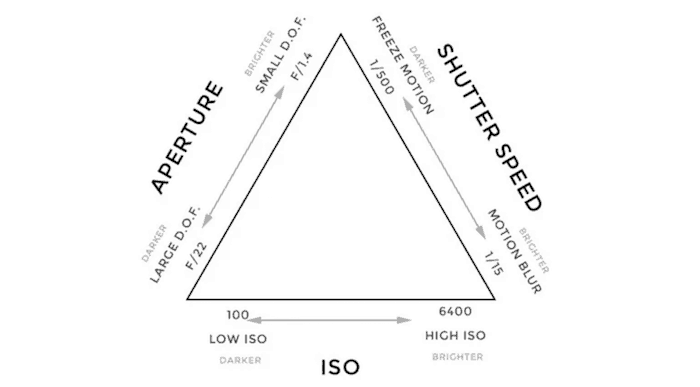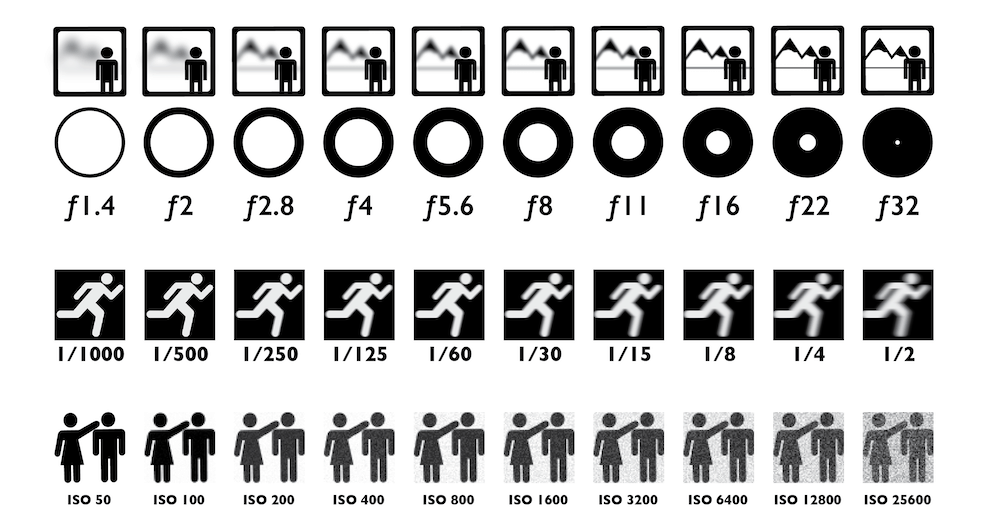At Two Fish Divers all of our locations offer phenomenal underwater photography opportunities from wide-angle in Bunaken and Lembongan through to the macro critters surrounding Amed and the world-famous Lembeh Strait. If you want to experience both wide and macro in one trip check out Gili Air and South Lombok – but truth be known, you can actually capture both wide and macro in all of our Indonesian diving destinations.
Are you trying to improve your underwater photography? Are you finding it tricky to understand some of the complex guides on the internet because you seem to be missing some of the basics? Here we explain some of the most commonly used terms that relate to camera settings, what each of them means, and how it affects your images!

Aperture, shutter speed and ISO work together to control your Exposure
Aperture
This is the first common photography term you should learn. Simply put, aperture is the size of the opening in the lens. Think of the lens as a window—large windows or wide angles let in more light, while small windows let in less light. Wide-open aperture camera settings will let more light into the image for a brighter photo, while a smaller aperture lets in less light. Aperture is measured in f-stops; a small f-stop like f/1.8 is a wide opening, a large f-stop like f/22 is a very narrow one. Aperture is one of three camera settings that determine an image’s exposure, or how light or dark it is. Aperture also affects how much of the image is in focus—wide apertures result in that creamy, unfocused background while narrow apertures keep more of the image sharp.
Aspect Ratio
If you’ve ever printed images before, you’ve probably noticed that an 8 x 10 usually crops from the original image. That’s due to aspect ratio. Aspect ratio is simply the ratio of the height to width. An 8 x 10 has an equal aspect ratio to a 4 x 5, but a 4 x 7 image is a bit wider. You can change the aspect ratio in your camera if you know how you’d like to print your image, or you can crop your photo when you edit it to the right ratio.

This image has a shallow depth of field with the area in focus (front to back) being very short – around the fishes eyes
Depth of Field
Depth of field is a photography term that refers to how much of the image is in focus. The camera will focus on one distance, but there’s a range of distance in front and behind that point that stays sharp—that’s depth of field. Portraits often have a soft, unfocused background—this is a shallow depth of field. Landscapes, on the other hand, often have more of the image in focus—this is a large depth of field, with a big range of distance that stays sharp.

This photo has a very wide depth of field with the area of the image in focus stretching from the anemone in front back to the diver
Exposure
Exposure is how light or dark an image is. An image is created when the camera sensor (or film strip) is exposed to light—that’s where the term originates. A dark photo is considered underexposed, or it wasn’t exposed to enough light; a light photo is overexposed or exposed to too much light. Exposure is controlled through three camera settings: aperture, shutter speed and ISO.
Focal Length
The focal length describes the distance in millimeters between the lens and the image it forms on the film. It informs the angle of view (how much of what is being shot will be captured) and the magnification (how large things will appear). Essentially, the focal length is how ‘zoomed in’ your images will appear. For example, a Canon (or Nikon or Olympus) 35mm lens will create images that appear more ‘zoomed in’ than a Canon 18mm.
Focus
When your eyes focus on an object that’s close to you, the objects far away will appear blurry. The common photography term “focus” has the same meaning. Something that is in focus is sharp, while an object that is out-of-focus isn’t sharp. Different focus areas determine if the camera is focusing on multiple points or one user-selected point.

This coral is a great example of strong focus with the coral tentacles appearing crisp and detailed
ISO
The ISO determines how sensitive the camera is to light. For example, an ISO of 100 means the camera isn’t very sensitive—great for shooting in the daylight. An ISO 3200 means the camera is very sensitive to light, so you can use that higher ISO for getting shots in low light. The trade off is that images at high ISO camera settings appear to be grainy and have less detail. ISO is balanced with aperture and shutter speed to get a proper exposure.
Shutter Speed
The shutter speed is the part of the camera that opens and closes to let light in and take a picture. The shutter speed is how long that shutter stays open, written in seconds or fractions of a second, like 1/200 s. or 1”, with the “ symbol often used to designate an entire second. The longer the shutter stays open, the more light that is let in. But, anything that moves while the shutter is open will become a blur, and if the entire camera moves while the shutter is open the whole image will be blurry—that’s why tripods are necessary for longer shutter speeds.

White balance helps your camera to cope with colour loss caused by low lighting underwater
White Balance
Your eyes automatically adjust to different light sources, but a camera can’t do that—that’s why sometimes you take an image and it looks very blue or very yellow. Using the right white balance camera settings will make what’s white in real life actually appear white in the photo. There’s an auto white balance setting, but like any automatic setting, it’s not always accurate. You can use a preset based on what light you are shooting in like sun or tungsten light bulbs, or you can take a picture of a white object and manually set the white balance.
Are you ready to put your new knowledge of camera settings to the test? Did you know that at all Two Fish Dive Resorts we cater to those with camera equipment? We have fresh water buckets on our boats for rinsing your cameras between dives and for keeping them cool, our resort rooms have plenty of power points for charging your batteries and our teams love nothing more than sitting down with you after diving and taking a look at your images.
To make a booking or for more information about our services and facilities for photographers fill in the form below and we will get right back to you.







